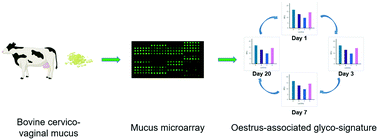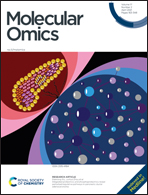Examination of oestrus-dependent alterations of bovine cervico-vaginal mucus glycosylation for potential as optimum fertilisation indicators†
Abstract
Oestrus is the period in the sexual cycle of female mammals where they become most receptive to mating and are most fertile. Efficient detection of oestrus is a key component in successful reproductive livestock management programmes. Oestrus detection in cattle is most often performed by visual observation, such as mounting behaviour and standing heat, to facilitate more successful prediction of optimal time points for artificial insemination. This time-consuming method requires a skilled, diligent observer. Biological measurements using easily accessible biomolecules in the cervico-vaginal mucus could provide an alternative strategy to physical methods of oestrus detection, providing an inexpensive means of rapidly and accurately assessing the onset of oestrus. In this study, glycosylation changes in cervico-vaginal mucus from three heifers following oestrus induction were investigated as a proof of concept to assess whether potential glycosylation-based trends could be useful for oestrus stage indication. Mucus collected at different time points following oestrus induction was immobilised in a microarray format and its glycosylation interrogated with a panel of fluorescently labelled lectins, carbohydrate-binding proteins with different specificities. Individual animal-specific glycosylation patterns were observed, however each pattern followed a similar trend around oestrus. This unique oestrus-associated glycosylation was identified by a combination of relative binding of the lectins SNA-I and WFA for each animal. This alteration in cervico-vaginal mucus glycosylation could potentially be exploited in future to more accurately identify optimal fertilisation intervention points compared to visual signs. More effective oestrus biomarkers will lead to more successful livestock reproductive programmes, decreasing costs and animal stress.



 Please wait while we load your content...
Please wait while we load your content...